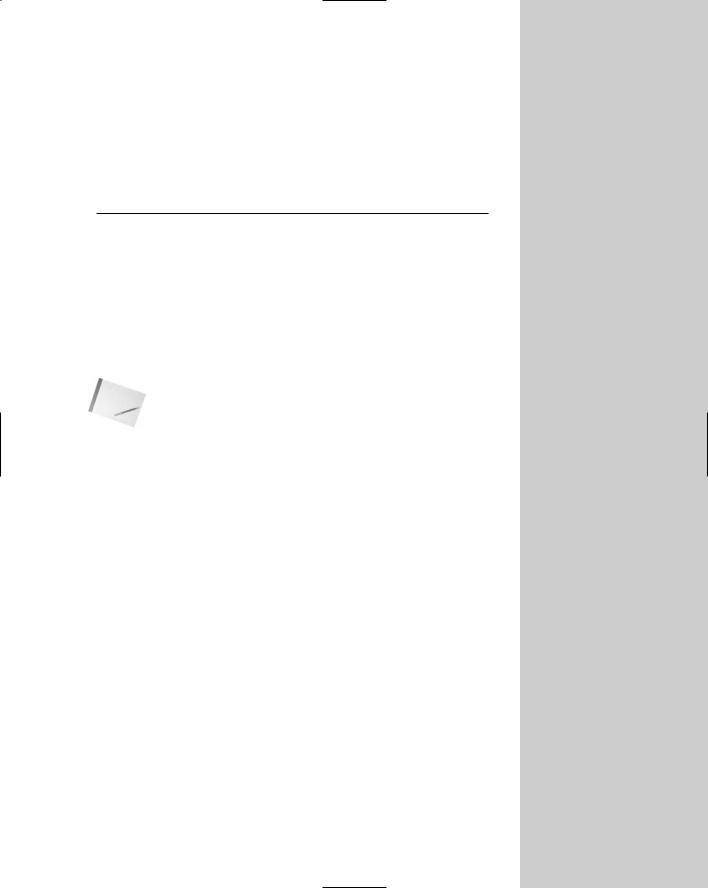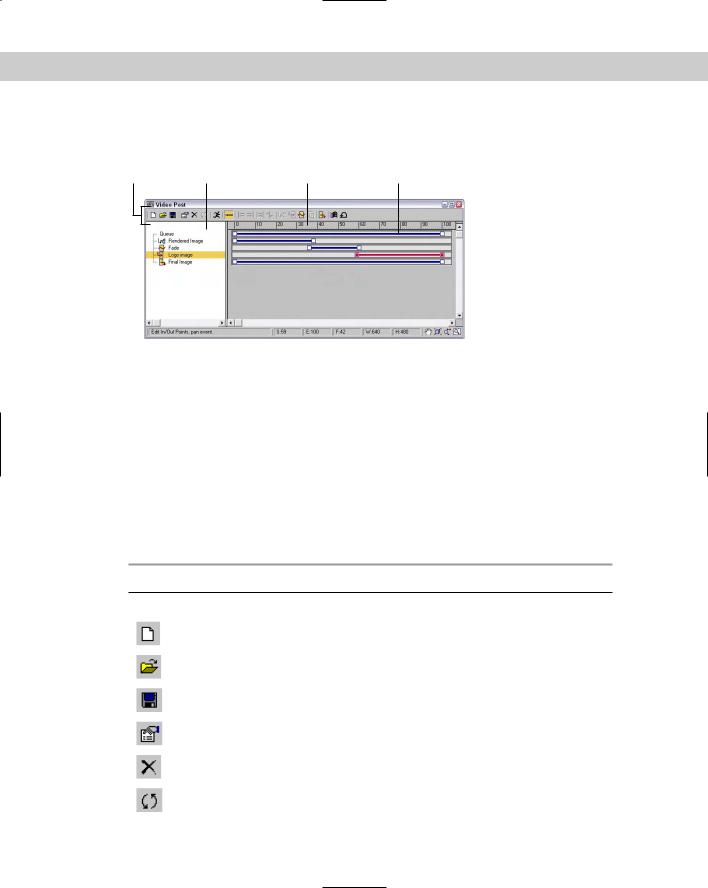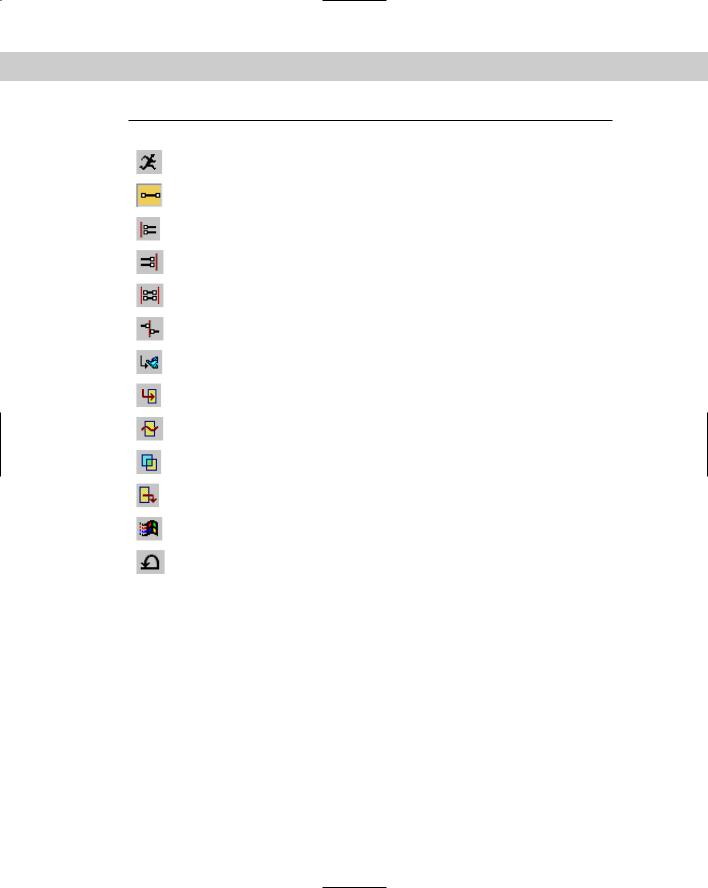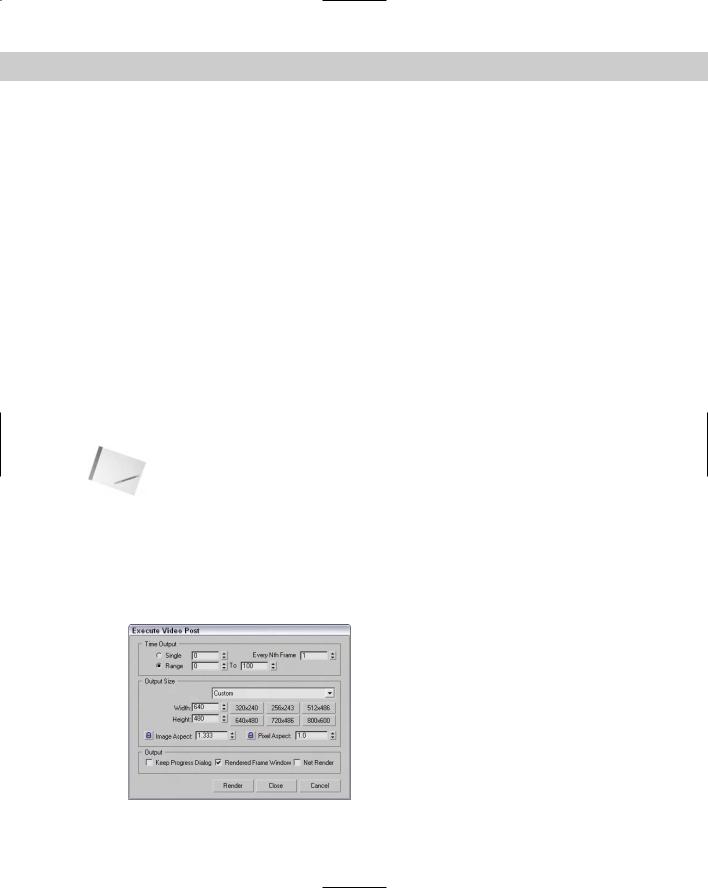
- •Preface
- •About This Book
- •Acknowledgments
- •Contents at a Glance
- •Contents
- •Relaxing at the Beach
- •Dressing the Scene
- •Animating Motion
- •Rendering the Final Animation
- •Summary
- •The Interface Elements
- •Using the Menus
- •Using the Toolbars
- •Using the Viewports
- •Using the Command Panel
- •Using the Lower Interface Bar Controls
- •Interacting with the Interface
- •Getting Help
- •Summary
- •Understanding 3D Space
- •Using the Viewport Navigation Controls
- •Configuring the Viewports
- •Working with Viewport Backgrounds
- •Summary
- •Working with Max Scene Files
- •Setting File Preferences
- •Importing and Exporting
- •Referencing External Objects
- •Using the File Utilities
- •Accessing File Information
- •Summary
- •Customizing Modify and Utility Panel Buttons
- •Working with Custom Interfaces
- •Configuring Paths
- •Selecting System Units
- •Setting Preferences
- •Summary
- •Creating Primitive Objects
- •Exploring the Primitive Object Types
- •Summary
- •Selecting Objects
- •Setting Object Properties
- •Hiding and Freezing Objects
- •Using Layers
- •Summary
- •Cloning Objects
- •Understanding Cloning Options
- •Mirroring Objects
- •Cloning over Time
- •Spacing Cloned Objects
- •Creating Arrays of Objects
- •Summary
- •Working with Groups
- •Building Assemblies
- •Building Links between Objects
- •Displaying Links and Hierarchies
- •Working with Linked Objects
- •Summary
- •Using the Schematic View Window
- •Working with Hierarchies
- •Setting Schematic View Preferences
- •Using List Views
- •Summary
- •Working with the Transformation Tools
- •Using Pivot Points
- •Using the Align Commands
- •Using Grids
- •Using Snap Options
- •Summary
- •Exploring the Modifier Stack
- •Exploring Modifier Types
- •Summary
- •Exploring the Modeling Types
- •Working with Subobjects
- •Modeling Helpers
- •Summary
- •Drawing in 2D
- •Editing Splines
- •Using Spline Modifiers
- •Summary
- •Creating Editable Mesh and Poly Objects
- •Editing Mesh Objects
- •Editing Poly Objects
- •Using Mesh Editing Modifiers
- •Summary
- •Introducing Patch Grids
- •Editing Patches
- •Using Modifiers on Patch Objects
- •Summary
- •Creating NURBS Curves and Surfaces
- •Editing NURBS
- •Working with NURBS
- •Summary
- •Morphing Objects
- •Creating Conform Objects
- •Creating a ShapeMerge Object
- •Creating a Terrain Object
- •Using the Mesher Object
- •Working with BlobMesh Objects
- •Creating a Scatter Object
- •Creating Connect Objects
- •Modeling with Boolean Objects
- •Creating a Loft Object
- •Summary
- •Understanding the Various Particle Systems
- •Creating a Particle System
- •Using the Spray and Snow Particle Systems
- •Using the Super Spray Particle System
- •Using the Blizzard Particle System
- •Using the PArray Particle System
- •Using the PCloud Particle System
- •Using Particle System Maps
- •Controlling Particles with Particle Flow
- •Summary
- •Understanding Material Properties
- •Working with the Material Editor
- •Using the Material/Map Browser
- •Using the Material/Map Navigator
- •Summary
- •Using the Standard Material
- •Using Shading Types
- •Accessing Other Parameters
- •Using External Tools
- •Summary
- •Using Compound Materials
- •Using Raytrace Materials
- •Using the Matte/Shadow Material
- •Using the DirectX 9 Shader
- •Applying Multiple Materials
- •Material Modifiers
- •Summary
- •Understanding Maps
- •Understanding Material Map Types
- •Using the Maps Rollout
- •Using the Map Path Utility
- •Using Map Instances
- •Summary
- •Mapping Modifiers
- •Using the Unwrap UVW modifier
- •Summary
- •Working with Cameras
- •Setting Camera Parameters
- •Summary
- •Using the Camera Tracker Utility
- •Summary
- •Using Multi-Pass Cameras
- •Creating Multi-Pass Camera Effects
- •Summary
- •Understanding the Basics of Lighting
- •Getting to Know the Light Types
- •Creating and Positioning Light Objects
- •Viewing a Scene from a Light
- •Altering Light Parameters
- •Working with Photometric Lights
- •Using the Sunlight and Daylight Systems
- •Using Volume Lights
- •Summary
- •Selecting Advanced Lighting
- •Using Local Advanced Lighting Settings
- •Tutorial: Excluding objects from light tracing
- •Summary
- •Understanding Radiosity
- •Using Local and Global Advanced Lighting Settings
- •Working with Advanced Lighting Materials
- •Using Lighting Analysis
- •Summary
- •Using the Time Controls
- •Working with Keys
- •Using the Track Bar
- •Viewing and Editing Key Values
- •Using the Motion Panel
- •Using Ghosting
- •Animating Objects
- •Working with Previews
- •Wiring Parameters
- •Animation Modifiers
- •Summary
- •Understanding Controller Types
- •Assigning Controllers
- •Setting Default Controllers
- •Examining the Various Controllers
- •Summary
- •Working with Expressions in Spinners
- •Understanding the Expression Controller Interface
- •Understanding Expression Elements
- •Using Expression Controllers
- •Summary
- •Learning the Track View Interface
- •Working with Keys
- •Editing Time
- •Editing Curves
- •Filtering Tracks
- •Working with Controllers
- •Synchronizing to a Sound Track
- •Summary
- •Understanding Your Character
- •Building Bodies
- •Summary
- •Building a Bones System
- •Using the Bone Tools
- •Using the Skin Modifier
- •Summary
- •Creating Characters
- •Working with Characters
- •Using Character Animation Techniques
- •Summary
- •Forward versus Inverse Kinematics
- •Creating an Inverse Kinematics System
- •Using the Various Inverse Kinematics Methods
- •Summary
- •Creating and Binding Space Warps
- •Understanding Space Warp Types
- •Combining Particle Systems with Space Warps
- •Summary
- •Understanding Dynamics
- •Using Dynamic Objects
- •Defining Dynamic Material Properties
- •Using Dynamic Space Warps
- •Using the Dynamics Utility
- •Using the Flex Modifier
- •Summary
- •Using reactor
- •Using reactor Collections
- •Creating reactor Objects
- •Calculating and Previewing a Simulation
- •Constraining Objects
- •reactor Troubleshooting
- •Summary
- •Understanding the Max Renderers
- •Previewing with ActiveShade
- •Render Parameters
- •Rendering Preferences
- •Creating VUE Files
- •Using the Rendered Frame Window
- •Using the RAM Player
- •Reviewing the Render Types
- •Using Command-Line Rendering
- •Creating Panoramic Images
- •Getting Printer Help
- •Creating an Environment
- •Summary
- •Creating Atmospheric Effects
- •Using the Fire Effect
- •Using the Fog Effect
- •Summary
- •Using Render Elements
- •Adding Render Effects
- •Creating Lens Effects
- •Using Other Render Effects
- •Summary
- •Using Raytrace Materials
- •Using a Raytrace Map
- •Enabling mental ray
- •Summary
- •Understanding Network Rendering
- •Network Requirements
- •Setting up a Network Rendering System
- •Starting the Network Rendering System
- •Configuring the Network Manager and Servers
- •Logging Errors
- •Using the Monitor
- •Setting up Batch Rendering
- •Summary
- •Compositing with Photoshop
- •Video Editing with Premiere
- •Video Compositing with After Effects
- •Introducing Combustion
- •Using Other Compositing Solutions
- •Summary
- •Completing Post-Production with the Video Post Interface
- •Working with Sequences
- •Adding and Editing Events
- •Working with Ranges
- •Working with Lens Effects Filters
- •Summary
- •What Is MAXScript?
- •MAXScript Tools
- •Setting MAXScript Preferences
- •Types of Scripts
- •Writing Your Own MAXScripts
- •Learning the Visual MAXScript Editor Interface
- •Laying Out a Rollout
- •Summary
- •Working with Plug-Ins
- •Locating Plug-Ins
- •Summary
- •Low-Res Modeling
- •Using Channels
- •Using Vertex Colors
- •Rendering to a Texture
- •Summary
- •Max and Architecture
- •Using AEC Objects
- •Using Architectural materials
- •Summary
- •Tutorial: Creating Icy Geometry with BlobMesh
- •Tutorial: Using Caustic Photons to Create a Disco Ball
- •Summary
- •mental ray Rendering System
- •Particle Flow
- •reactor 2.0
- •Schematic View
- •BlobMesh
- •Spline and Patch Features
- •Import and Export
- •Shell Modifier
- •Vertex Paint and Channel Info
- •Architectural Primitives and Materials
- •Minor Improvements
- •Choosing an Operating System
- •Hardware Requirements
- •Installing 3ds max 6
- •Authorizing the Software
- •Setting the Display Driver
- •Updating Max
- •Moving Max to Another Computer
- •Using Keyboard Shortcuts
- •Using the Hotkey Map
- •Main Interface Shortcuts
- •Dialog Box Shortcuts
- •Miscellaneous Shortcuts
- •System Requirements
- •Using the CDs with Windows
- •What’s on the CDs
- •Troubleshooting
- •Index

Using the Video
Post Interface
Post-production typically takes place in an external package, such as Discreet’s Combustion or Adobe’s After Effects, but Max
includes an interface to add some effects.
You can use the Video Post window to composite the final rendered image with several other images and filters. These filters let you add lens effects like glows and flares, and other effects like blur and fade, to the final output. The Video Post window provides a post-processing environment within the Max interface.
Note Many of the post-processing effects such as glows and blurs are also available as render effects, but the Video Post window is capable of much more.
Completing Post-Production with the Video Post Interface
Post-production is the work that comes after the scene is rendered. It is the time when you add effects, such as glows and highlights, as well as add transitional effects to an animation. For example, if you want to include a logo in the lower right-hand corner of your animation, you can create and render the logo and composite several rendered images into one during post-production.
Video Post interface is the post-processing interface within Max that you can use to combine the current scene with different images, effects, and image processing filters. Compositing is the process of combining several different images into a single image. Each element of the composite is included as a separate event. These events are all lined up in a queue and processed in the order in which they appear in the queue. The queue can also include looping events.
The Video Post interface, like the Render Scene dialog box (covered in Chapter 41, “Rendering Basics”), provides another way to produce final output. You can think of the Video Post process as an artistic assembly line. As the image moves down the line, each item in the queue adds an image, drops a rendered image on the stack, or applies a filter effect. This process continues until the final output event is reached.
47C H A P T E R
In This Chapter
Learning about post-processing
Using the Video
Post interface
Working with sequences
Understanding the various filter types
Adding and editing events
Specifying event ranges
Using the Lens
Effects filters

1094 Part XI Compositing and Post-Production
The Video Post interface, shown in Figure 47-1, includes a toolbar, a pane of events and ranges, and a status bar. You can open it by choosing Rendering Video Post.
Toolbar Queue pane |
Time bar |
Range pane |
Figure 47-1: The Video Post interface lets you composite images with your final rendering.
In many ways, the Video Post interface is similar to the Track View interfaces. Each event is displayed as a track in the Queue pane to the left. To the right is the Range pane where the range for each track is displayed as lines with square boxes at each end. You can edit these ranges by dragging the squares on either end. The time bar, above the Range pane, displays the frames for the current sequence, and the status bar at the bottom of the interface includes information and view buttons.
The Video Post toolbar
At the top of the Video Post interface is a toolbar with several buttons for managing the Video Post features. Table 47-1 shows and explains these buttons.
Table 47-1: Video Post Toolbar Buttons
Toolbar Button |
Name |
Description |
|
|
|
|
New Sequence |
Creates a new sequence |
|
Open Sequence |
Opens an existing sequence |
|
Save Sequence |
Saves the current sequence |
|
Edit Current Event |
Opens the Edit Current Event dialog box where you can |
|
|
edit events |
|
Delete Current Event |
Removes the current event from the sequence |
|
Swap Events |
Changes the position in the queue of two selected |
|
|
events |

Chapter 47 Using the Video Post Interface 1095
|
Toolbar Button |
Name |
Description |
|
|
|
|
|
|
Execute Sequence |
Runs the current sequence |
|
|
Edit Range Bar |
Enables you to edit the event ranges |
|
|
Align Selected Left |
Aligns the left ranges of the selected events |
|
|
Align Selected Right |
Aligns the right ranges of the selected events |
|
|
Make Selected |
Makes the ranges for the selected events the same size |
|
|
Same Size |
|
|
|
Abut Selected |
Places event ranges end-to-end |
|
|
Add Scene Event |
Adds a rendered scene to the queue |
|
|
Add Image Input Event |
Adds an image to the queue |
|
|
Add Image Filter Event |
Adds an image filter to the queue |
|
|
Add Image Layer Event |
Adds a compositing plug-in to the queue |
|
|
Add Image Output Event Sends the final composited image to a file or device |
|
|
|
Add External Event |
Adds an external image-processing event to the queue |
|
|
Add Loop Event |
Causes other events to loop |
|
|
|
|
The Video Post Queue and Range panes
Below the toolbar are the Video Post Queue and Range panes. The Queue pane is on the left; it lists all the events to be included in the post-processing sequence in the order in which they are processed. You can rearrange the order of the events by dragging an event in the queue to its new location.
You can select multiple events by holding down the Ctrl key and clicking the event names, or you can select one event, hold down the Shift key, and click another event to select all events between the two.
Each event has a corresponding range that appears in the Range pane to the right. Each range is shown as a line with a square on each end. The left square marks the first frame of the event, and the right square marks the last frame of the event. You can expand or contract these ranges by dragging the square on either end of the range line.

1096 Part XI Compositing and Post-Production
If you click the line between two squares, you can drag the entire range. If you drag a range beyond the given number of frames, then additional frames are added.
The time bar is at the top of the Range pane. This bar shows the number of total frames included in the animation. You can also slide the time bar up or down to move it closer to a specific track by dragging it.
The Video Post status bar
The status bar includes a prompt line, several value fields, and some navigation buttons. The fields to the right of the prompt line include Start, End, Current Frames, and the Width and Height of the image. The navigation buttons include (in order from left to right) Pan, Zoom Extents, Zoom Time, and Zoom Region.
Working with Sequences
All the events that are added to the Queue pane make up a sequence. You can save these sequences and open them at a later time. The Execute Sequence button, found on the toolbar, starts the compositing process.
To save a sequence, click the Save button on the toolbar to open the Save Sequence dialog box, where you can save the queue sequence. Sequences are saved along with the Max file when the scene is saved, but they can also be saved independently of the scene. By default, these files are saved with the .VPX extension in the vpost directory.
Note |
Saving a sequence as a VPX file maintains the elements of the queue, but it resets all param- |
|
eter settings. Saving the file as a Max file maintains the queue order along with the parame- |
|
ter settings. |
You can open saved sequences using the Open Sequence button on the toolbar. When a saved sequence is opened, all the current events are deleted. Clicking the New Sequence button also deletes any current events.
The Execute Sequence toolbar button opens the Execute Video Post interface, shown in Figure 47-2. The controls in this dialog box work exactly the way those in the Render Scene dialog box work.
Figure 47-2: The Execute Video Post interface includes the controls for producing the queue output.
